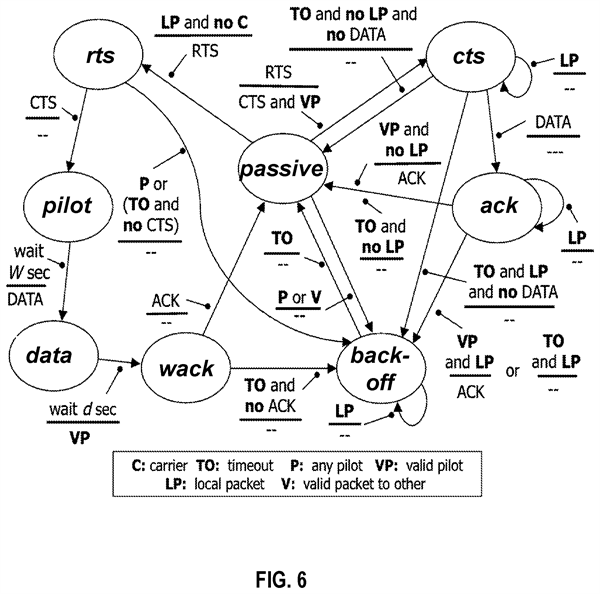Carrier Sense Multiple Access With Collision Avoidance And Pilots (CSMA/CAP)
Background
In most wireless ad-hoc multi-hop networks, a node competes for access to shared wireless medium, often resulting in collisions (interference). A node is commonly equipped with a transceiver that possesses mounted half-duplex omnidirectional antenna. Transmission degradation can occur when terminals are hidden from each other by physical structure, such as buildings. Moreover, since half-duplex nodes cannot receive while transmitting, not all packets sent by different terminals are detected by one another. In fact, no channel-access protocol based on the traditional handshake over a single channel can guarantee collision-free transmissions. Problems can arise in multi-hop wireless networks when hidden terminals, exposed transmitters, or exposed receivers are present.
Technology Description
To overcome these challenges, researchers at UC Santa Cruz (UCSC) have developed a new networking approach called Carrier-Sense Multiple Access with Collision Avoidance and Pilots (CSMA/CAP). This new scheme is introduced as a simple extension of the traditional CSMA collision avoidance (CA) approach for ad-hoc networks utilizing single half-duplex radios for each node and by leveraging carrier-detection techniques at the physical layer. Using carrier sensing to access the common channel under the CSMA/CAP framework, a node with a data packet to send transmits a request-to-send (RTS) packet, and if the RTS is sent without interference, the receiver sends a clear-to-send (CTS) packet back followed by a pilot. A sender that receives the CTS back sends its data packet after a delay to let the pilot be heard and then transmits its own pilot to make the total transmission time equal to a maximum data-packet length. Finally, the receiver sends its acknowledgement after receiving the data packet and pilot from the sender. UCSC’s CSMA/CAP ensures that data packets and their acknowledgements are sent without multiple-access interference. While there is overhead with CSMA/CAP in eliminating unwanted interference, the research results show that it is small, and that CSMA/CAP significantly improves performance in standard CSMA when hidden terminals are involved.
Pictured: Eliminating MAI from exposed transmitters using pilots

Applications
Ad-hoc networking
Features/Benefits
- Simple extension of the traditional CSMA’s collision avoidance (CA) protocol; no need for complex physical-layer techniques.
- Eliminates stubborn collisions / interference in ad-hoc multi-hop networks.
- System does not require full-duplex transceivers; can operate using less expensive half-duplex transceivers.
- Methods perform far superior than conventional CSMA using hidden terminals.
Intellectual Property Information
| Country | Type | Number | Dated | Case |
| United States Of America | Issued Patent | 11,251,933 | 02/15/2022 | 2019-197 |
| United States Of America | Published Application | 20210271699 | 09/02/2021 | 2019-197 |
Related Materials
- Implementing Correct and Efficient Collision Avoidance in Multi-Hop Ad-Hoc Networks - 05/13/2019
- Garcia-Luna-Aceves, J.J., “Carrier-Tone Multiple Access with Collision Avoidance and Detection,” Proc. IEEE WCNC '18, Apr. 15-18, 2018, pp. 1-6, DOI: 10.1109/WCNC.2018.8377398. - 04/15/2018
- Garcia-Luna-Aceves, J.J. and Carvalho, M.M., “Collaborative Collision Detection with Half-Duplex Radios,” Proc. IEEE WCNC'18, Apr. 15-18, 2018, pp. 1-6, DOI: 10.1109/WCNC.2018.8377339. - 04/15/2018
- Garcia-Luna-Aceves, J.J., “Carrier-Sense Multiple Access with Collision Avoidance and Detection,” Proc. ACM MSWIM '17, Nov. 21-25, 2017, pp. 53-61, DOI: 10.1145/3127540.3127551. - 11/21/2017
- Garcia-Luna-Aceves, J.J., “Carrier Resolution Multiple Access,” Proc. ACM PE-WASUN '17, Nov. 2017, pp. 1-8, DOI: 10.1145/3134829.3134832. - 11/21/2017
Contact
- Marc Oettinger
- marc.oettinger@ucsc.edu
- tel: View Phone Number.
Inventors
- Garcia-Luna-Aceves, JJ
Other Information
Keywords
Collision avoidance, Data packet, Multiple Access Interference, Half-duplex transceivers, Router, Networking, Mesh network, Ad-hoc network
Categorized As
Additional Technologies by these Inventors
- Queue-Sharing Multiple Access Protocol
- Differentiating Congestion Vs. Random Loss: A Method For Improving TCP Performance Over Wireless Links
- Scalable Integrated Services Architecture for Computer Networks
- Interference Management for Concurrent Transmission in Downlink Wireless Communications
- Tree-Based Ordered Multicasting in Computer Networks
